Paul Casey, head of Shakespeare UK and Europe, casually mentioned one day that he’d never caught a blue shark and it was a long standing ambition he was keen to achieve. That sounded like a challenge to me, so we got our heads together and set about organising a trip. Both being flat out with work, we could only allow ourselves two days to fish, so our choice of venue would be critical.
My instincts opted for Ireland and a chat with Norman Dunlop, Sea Angling Advisor to the Central Fisheries Board, saw us settle on Castletownbere way down in the far southwest corner of Ireland. We’d be fishing with John Angles who runs “Tigger” a 31ft Pro Charter purpose built angling boat from the port and an experienced shark chaser.
The summer never happened as we all know and it rained and blew constantly. All the time I had visions of our brief shark trip being cancelled. Yet as we boarded the Stena Ferry in Fishguard the sun was out, high pressure was sat right over the UK and Ireland, and the forecast was that it was set to stay that way for the next few days.
The problem was that with the weather being so bad right up until our trip very few shark trips had been made, either by Jon, or by any other skippers remotely close to
, so we had no guarantees the sharks were even there in any number.
ALL ABOARD
Boarding the boat that morning, extra pressure was added. Also fishing with us was French journalist Philippe Duchesne from Peche En Mer magazine, and guess what, he’d not caught a shark before either!
Heading out from the port the intention was to fish mackerel for bait under the inshore headlands, then head out about 15 miles or so. The sharks are often much closer here, but both Jon and I felt that distance would be an advantage given the recent bad weather.
The mackerel were sporadic, but intensive fishing got a box full, which would be more than enough for the days fishing.
Also aboard were Eamon Power and Ian Mulligan, both top Irish anglers, but although they’d be bottom fishing and not sharking, they set about cutting up the mackerel for the chum while I rigged up four shark rods as we steamed for the horizon. With cruising speeds well over 20-knots we were there before we knew it.
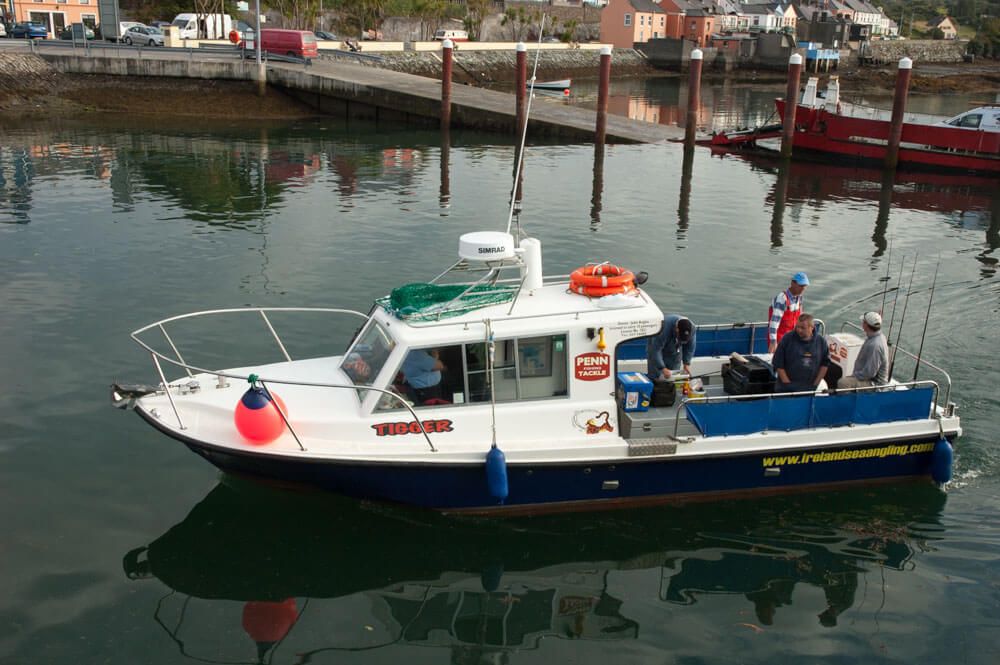
SHARK!
On the shark grounds the surface temperature was 16C and the depth around 300-feet, but I wasn’t confident that the sharks would be working the upper surface layers as offshore the mackerel were few and far between. The sharks would be in the vicinity of the thermocline hunting looking upwards for silhouette targets and “feeling” for baitfish shoals above them.
Also watching our initial drift it was quite slow, but then would pick up slightly when the tide turned to flood. This also meant that the chum trail would sink deep as it worked away from the boat. I’d also spotted algal bloom in the surface water which robs the water of oxygen. With all this in mind I opted to set a bait about 90-feet down, then stagger the others at 60-feet, 40-feet and just 20-feet nearest the boat. My faith was in the deepest set bait!
So that I know the depth of my rigged balloons at a glance I always put dark blue out furthest as it stands up better when viewed against the sea, then red, then yellow, with green or any other colour tightest to the boat.
Two big sacks of chum went over the side, one on the port cabin cleat, the other on the starboard bow cleat, both just set to touch water as the boat rolled in the calm settled swell. Within 5 minutes we had a slick going which oiled the surface water.
With my instincts telling me the sharks would be deep I also intended to cut up inch chunks of mackerel body, and periodically drop them over the stern. These sink quicker and deeper than the chum bits will and can bring up sharks that are working deeper than the chum slick.
Nothing else to do now but wait! The lads were fishing on the bottom, but the ground was clean and only giving up whiting, haddock, small gurnards, dabs and a few mackerel.
Time ticked on, 12pm, 1pm, then the tide turned to flood just before 2pm. I chunked some mackerel over the side and waited some more. Bang on queue at 2.20 the deepest set rig was taken by a shark that bolted off making the reel scream. Paul was on it like a flash and did everything exactly right letting the fish continue the run, then as it slowed, eased up the lever drag, let the rod pull over to the weight of the fish to set the hook, then let the fish run again.
The fish was deep, but steady rod pressure brought the fish slowly up through the water column. Paul was rightly trying to suppress his excitement, yet at the same time curb the urge to get the fish in as quickly as possible just in case it came off…we’ve all been there!
The shark made several short runs trying to gain depth, then swung deeper behind the boat. He needed to work the fish back around the stern to the port side where John uses a big purposely built net to secure and lift the shark so no damage is done ready for tag and release. The shark second guessed this manoeuvre and took off in the opposite direction dragging line with it. More pumping and working the fish brought it back.
Easing the shark towards the net it made one more shallow dive, then back on the surface John and the lads rolled the shark safely in to the net. It weighed around 30lbs, but had made one man very happy and achieved a 20-year ambition.
[caption id="attachment_14381" align="aligncenter" width="1000"]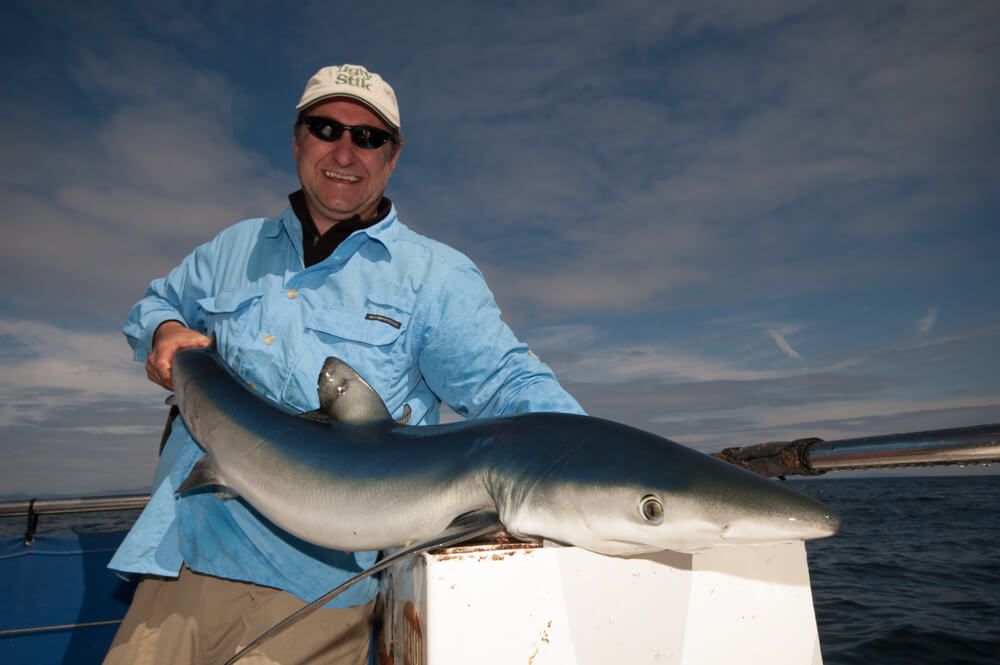 Ambition fulfilled, Paul Casey a very happy blue shark angler![/caption]
Ambition fulfilled, Paul Casey a very happy blue shark angler![/caption]
No time to waste though, we needed to get Philippe a shark next, and hopefully another shark for Paul, so back out went the balloons.
Time ticked by some more and it was close to 4pm when the deep bait roared away again. Philippe was unsure what to do and the language barrier in the heat of battle caused problems and the shark ran, then spat the bait. I whispered, or was it screamed, to Philippe to gently retrieve the bait a little. This often induces an unsure or spooked shark to re-hit the bait and this fish played to script grabbing the bait a second time and running fast away and deeper. Philippe set the hook and the fight was on.
This was a bigger fish and the light gear took maybe 30yds of line in the first run, paused, then went again. Steady pressure again brought the fish up slowly through the water column, then the rod went slack. Not having the rod in my own hands it took me several seconds to realise the fish was running towards him and both Jon and I simultaneously shouted “reel in quickly”, abruptly the line tightened and the smile reappeared on Philippe’s face.
It took another ten minutes to get the fish safely in the net, we guessed a 45lber after assessing the length and girth during the tagging process and we had one very happy Frenchmen shaking hands all round.
[caption id="attachment_14382" align="aligncenter" width="1000"]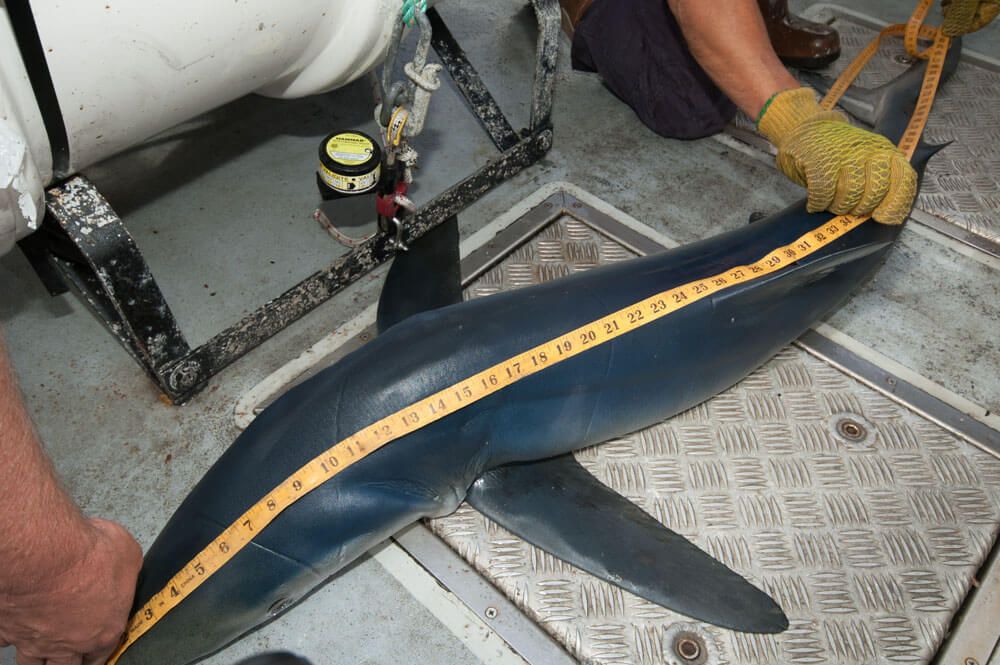 The skipper measures and tags a blue before return.[/caption]
The skipper measures and tags a blue before return.[/caption]
I winkled out a garfish on float gear, just for my annual species count, but unfortunately there were no more shark runs that day. But the lads had both got what they wanted, their first sharks, which are always a very special fish for any angler, and gained the deep desire to come back and do it all over again with a 100lber the next target.
[caption id="attachment_14383" align="aligncenter" width="1000"]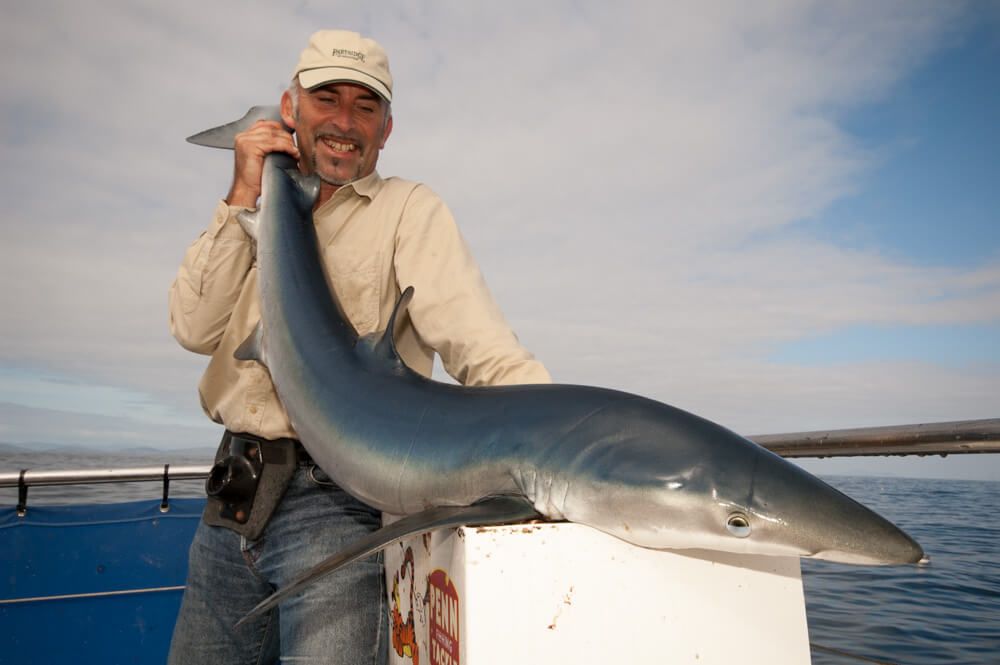 French journalist Philippe Duchesne with his blue shark.[/caption]
French journalist Philippe Duchesne with his blue shark.[/caption]
LINE UP A LING
The trip still had a day to run, and because we were initially unsure the sharks would be there, plus the lads had now caught their target fish, we were scheduled to tackle a wreck laying some 30 miles out in the Atlantic, plus we had the weather to do it.
She is the “California” a cruise ship originally holed up off Tory Island, rebuilt, then torpedoed off Castletownbere and laying in over 320-feet of water. Norman Dunlop and another old friend and work colleague Mike Hennessey from the Southwest Regional Fisheries Board would be fishing with us. Jon and Mike had been telling me that the wreck is a cracker for big ling and especially for the coveted Irish specimen pollack that needs to be over 12lbs to qualify.
Setting up with long 150lb flowing traces armed with size 10/0 hooks and mackerel flappers smothered with a luminous muppet some hot ling action was anticipated first.
Straight away both Mike Hennessey and Norman were hard in to good ling, Mike’s being around the 18lb mark and Normans a little smaller. We were hard in to the wreck and snapped off on the first drop, which is always frustrating.
[caption id="attachment_14384" align="aligncenter" width="999"]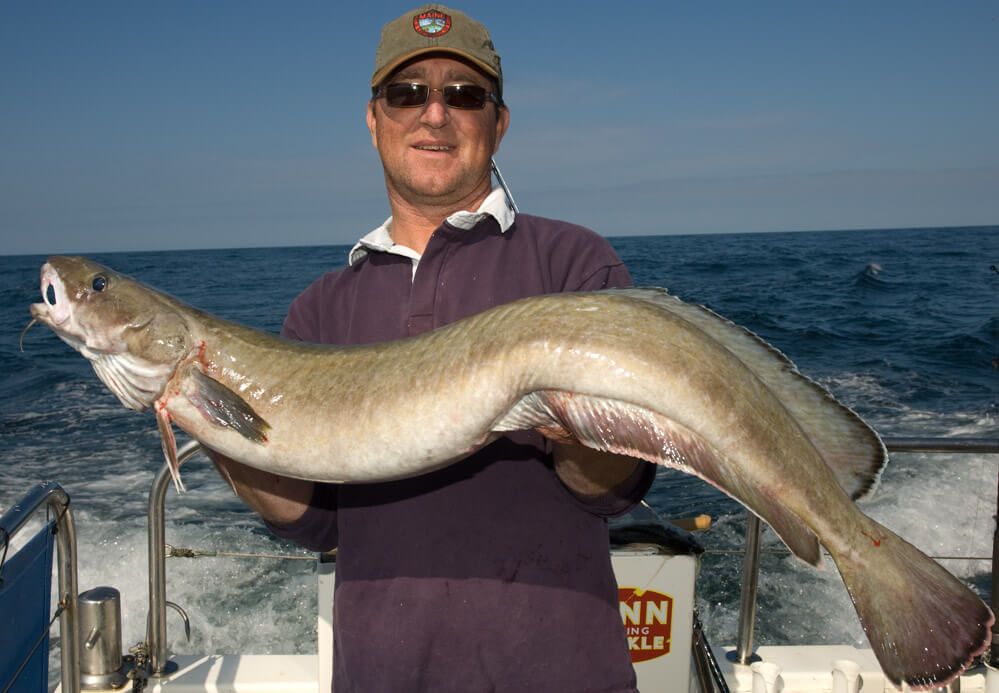 Mike Hennessey with a ling around 24lbs.[/caption]
Mike Hennessey with a ling around 24lbs.[/caption]
Over the next few drifts as the tide slackened a steady stream of ling came aboard, culminating in a long scrap between Mike and some unseen adversary far below. Gradually the fish showed colour and cracking looking fish around the 24lb mark felt the deck of the “Tigger”. The lads who’d fished this wreck before seemed a little disappointed we hadn’t done better, but I’d seen enough to want to come back and target a 30lb plus ling here.
POLLACK POWER
With the tide picking up it was pollack time. We switched to jumper rigs or flying collar rigs armed with weighted shads, big shads and artificial eels. Norman and I were first in with Norman bagging a cracking looking 11lber, and me with a hard fighting 8lber. Other pollack caught were between 4 and 9lbs.
Subsequent drifts produced some superb pollack fishing with fish touching that magical 12lbs, then Eamon from Dublin quietly sneaked in a huge fish that when weighed punched the scales down to 13lbs and is another Irish specimen for him. His mate Ian was also bagging pollack to well over 11lbs as was Philippe and Mike.
[caption id="attachment_14386" align="aligncenter" width="1000"]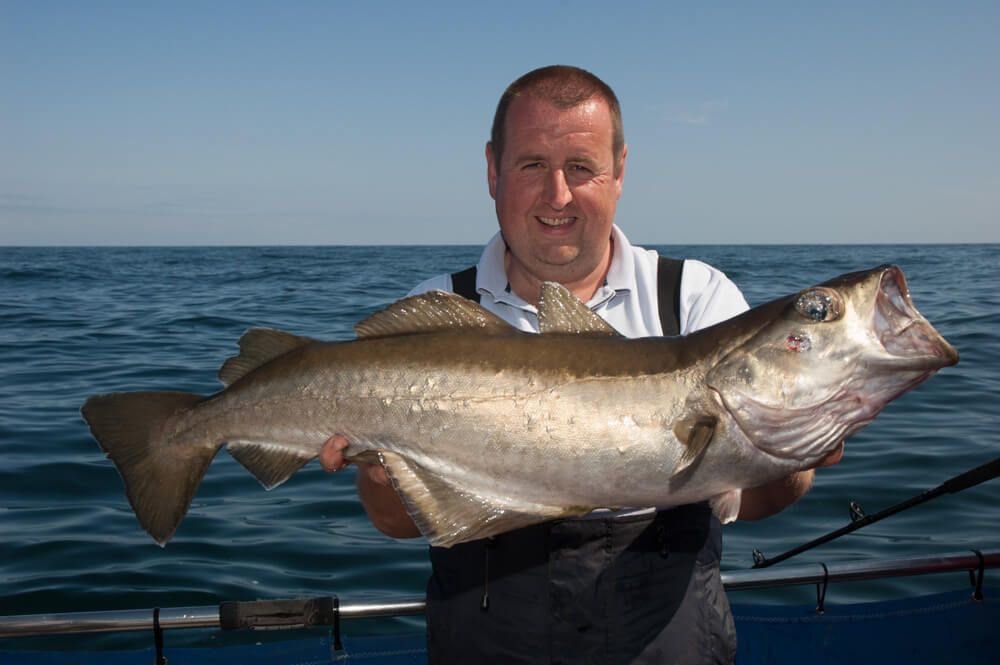 Ian Mulligan shows off a fine pollack![/caption]
Ian Mulligan shows off a fine pollack![/caption]
I was fishing alongside Paul and something wasn’t right for us. We were fishing similar techniques to the other guys, but not getting the numbers of fish we should have. I started to experiment to find out why.
First I changed lures around, but this didn’t seem to make much difference, then changed the trace length to see if that helped. Nope! I checked retrieve speeds and even changed to a slightly lighter lead to get more angle on the retrieve to see if that helped, but to no avail.
I decided on a complete rethink. I went for a thinner diameter Flying Collar Boom to reduce visual contact and vibration, switched to lighter 19lb SALT Fluoro carbon, lengthened the trace to 12ft, and chose an old and now no longer available big 9-inch Delta sandeel in dark red to give a big target silhouette. My next two drops produced a 9lb pollack and an 11lb pollack. I’d sussed it!
Paul had identical gear to me and was fishing light given the potential size of the fish with a MTI 20/40 Braid rod and 30lb braid with a 20lb mono leader and worked away quietly concentrating hard. I was watching his rod tip when it went slowly over to the pressure of a fish. He kept calm, didn’t react, just let the fish bore hard for the bottom.
I could tell this was a bigger fish, but kept stum and just watched the fight unfold. Paul took real time with the fish, skilfully working it up through the levels bit by bit. Norman was also watching the outcome and was first to see the colour and shout for the net. It broke surface and looked huge. On board it bounced the scales to just over 13lbs 8ozs and bagged Paul an Irish specimen pollack on his very first attempt.
[caption id="attachment_14385" align="aligncenter" width="1000"]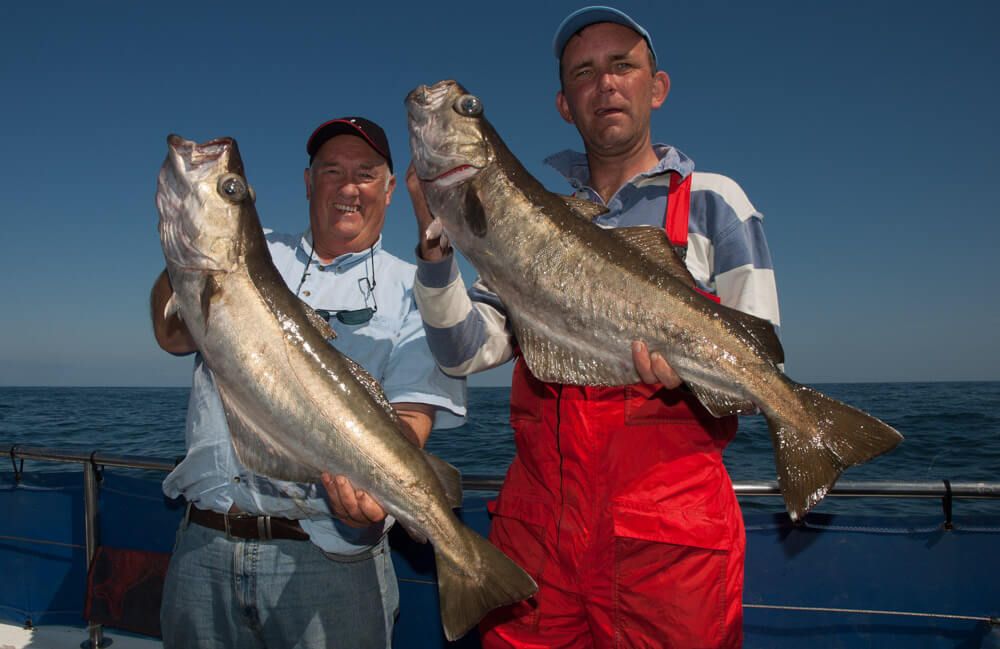 Norman Dunlop (left) Eamon Power (right) with two more fine pollack[/caption]
Norman Dunlop (left) Eamon Power (right) with two more fine pollack[/caption]
To put this fish in to perspective Norman has 16 different Irish specimen fish to his name, but has never in over 30-years fishing bagged a specimen pollack. They are one of the hardest to get due to the sheer numbers of pollack in Irish waters.
[caption id="attachment_14387" align="aligncenter" width="1000"]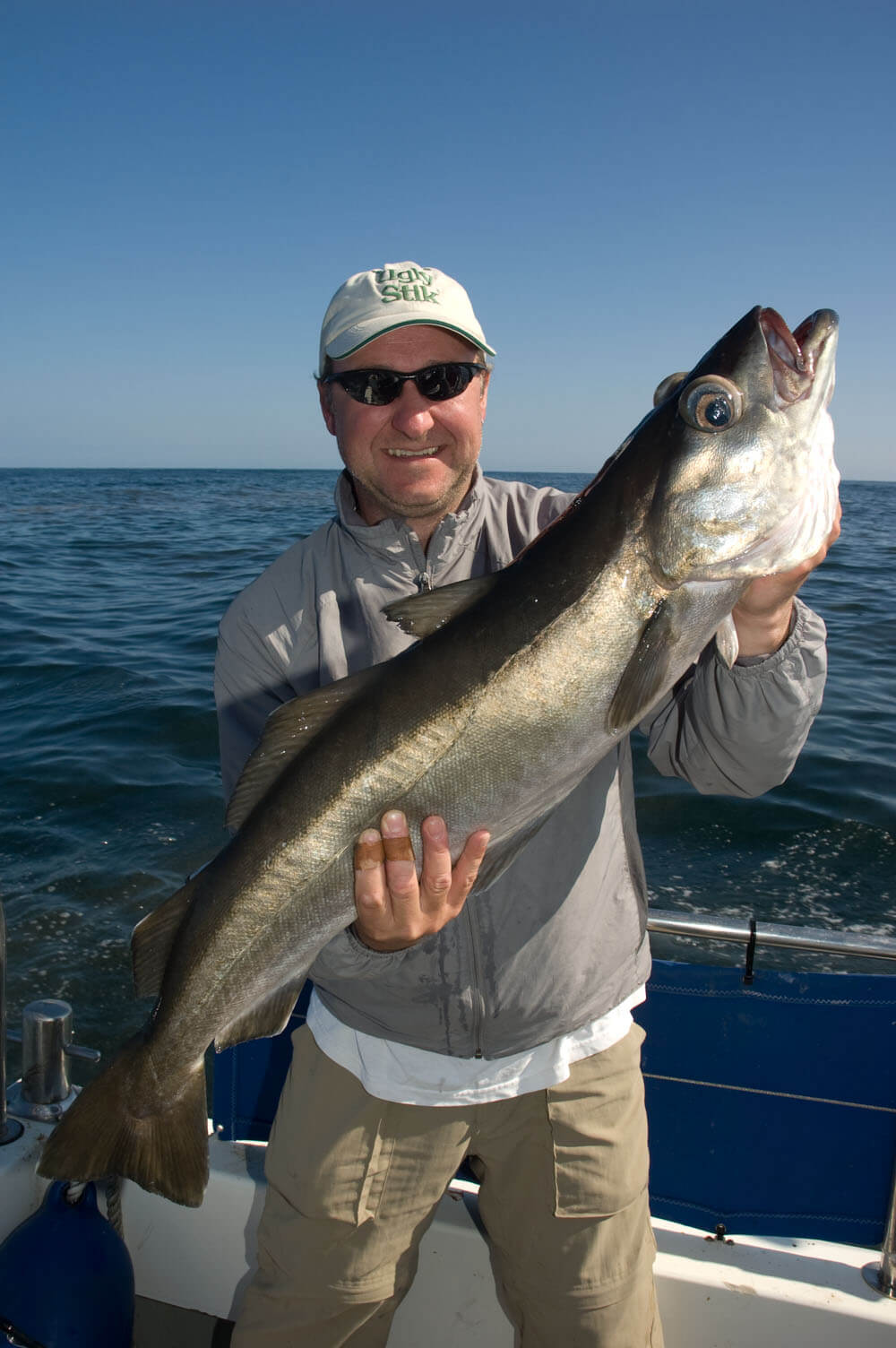 Paul Casey with an Irish Specimen Pollack weighing 13lbs 8ozs[/caption]
Paul Casey with an Irish Specimen Pollack weighing 13lbs 8ozs[/caption]
Summing up then, what a couple of days fishing! Paul bagged both his first shark and a rare Irish specimen pollack at the first attempt, Frenchman Philippe caught his first ever shark, plus caught ling and pollack to good size, and the icing on the cake was Eamon’s13lb specimen pollack to make it two for the day. What a result!
My thanks to Norman Dunlop and Mike Hennessey for their help and hard work, and also to John Angles, Skipper of the “Tigger” for making dreams come true!
[caption id="attachment_14388" align="aligncenter" width="1000"]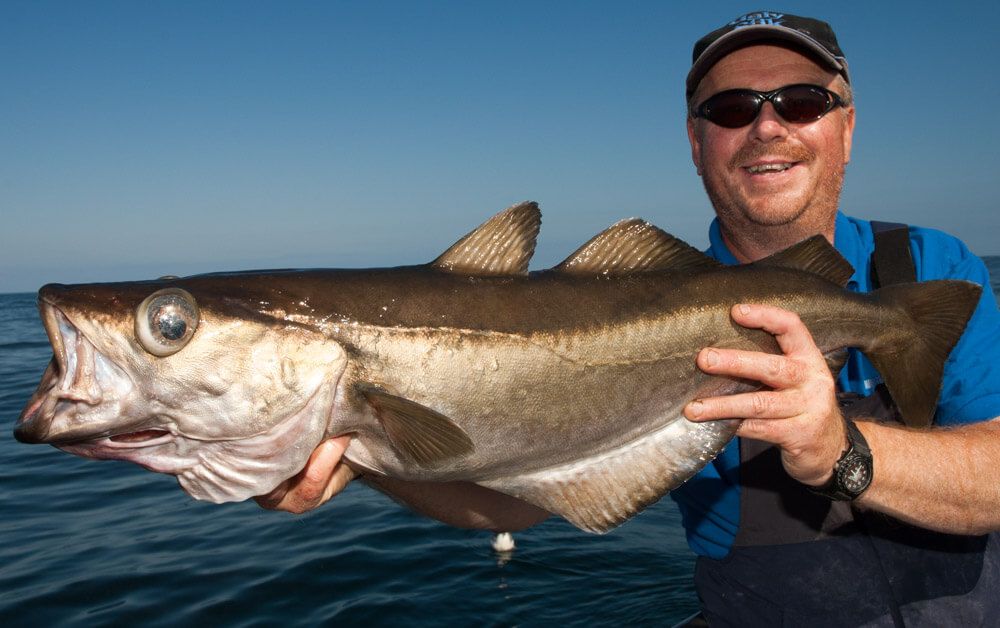 Mike also finds time to get in on the act…[/caption]
Mike also finds time to get in on the act…[/caption]
CHARTER SKIPPER
John Angles, Inches House, Eyeries, Beara, West Cork, Ireland. Tel: 00 353 27 74494. E-mail: info@eyeries.com . Website: www.irelandseaangling.com .
“Tigger” is also fully kitted out with modern Penn rods and reels if you choose not to bring your own gear.
TRAVEL
All the ferry information and for booking on-line as I did is available via www.stenaline.co.uk .
WHERE TO STAY
Check out … www.discoverireland.com and www.tourismireland.com for masses of information on this beautiful area, and you can also request information from info@tourismireland.com . Also www.ireland.ie .
We stayed at the Cametringane Hotel, Castletownbere, Co Cork. Tel: 00 353 27 70379. There are loads of Bed and Breakfast houses here too, plus other hotels to choose from.
There are good pubs with great food in Castletownbere and you can take your pick from any in the high street.
GENERAL INFORMATION
The Central Fisheries Board, Swords Business Camp, Swords, Co Dublin, Ireland. Tel: 00 353 1 8842 600 has a great website at www.cfb.ie. Click on Sea Fishing, then on Sea Fishing Maps For Ireland, and look at Co Cork and Castletownbere. In addition this site has masses of other useful information and practical fishing advice.
For shore fishing info, the Central Fisheries Board has one of their excellent shore mark info boards right on the quay opposite the Supervalu Supermarket.
ADMIRALTY CHARTS
Chart 2424 covers all of the fishing area out from Castletownbere.
My instincts opted for Ireland and a chat with Norman Dunlop, Sea Angling Advisor to the Central Fisheries Board, saw us settle on Castletownbere way down in the far southwest corner of Ireland. We’d be fishing with John Angles who runs “Tigger” a 31ft Pro Charter purpose built angling boat from the port and an experienced shark chaser.
The summer never happened as we all know and it rained and blew constantly. All the time I had visions of our brief shark trip being cancelled. Yet as we boarded the Stena Ferry in Fishguard the sun was out, high pressure was sat right over the UK and Ireland, and the forecast was that it was set to stay that way for the next few days.
The problem was that with the weather being so bad right up until our trip very few shark trips had been made, either by Jon, or by any other skippers remotely close to
, so we had no guarantees the sharks were even there in any number.
ALL ABOARD
Boarding the boat that morning, extra pressure was added. Also fishing with us was French journalist Philippe Duchesne from Peche En Mer magazine, and guess what, he’d not caught a shark before either!
Heading out from the port the intention was to fish mackerel for bait under the inshore headlands, then head out about 15 miles or so. The sharks are often much closer here, but both Jon and I felt that distance would be an advantage given the recent bad weather.
The mackerel were sporadic, but intensive fishing got a box full, which would be more than enough for the days fishing.
Also aboard were Eamon Power and Ian Mulligan, both top Irish anglers, but although they’d be bottom fishing and not sharking, they set about cutting up the mackerel for the chum while I rigged up four shark rods as we steamed for the horizon. With cruising speeds well over 20-knots we were there before we knew it.

SHARK!
On the shark grounds the surface temperature was 16C and the depth around 300-feet, but I wasn’t confident that the sharks would be working the upper surface layers as offshore the mackerel were few and far between. The sharks would be in the vicinity of the thermocline hunting looking upwards for silhouette targets and “feeling” for baitfish shoals above them.
Also watching our initial drift it was quite slow, but then would pick up slightly when the tide turned to flood. This also meant that the chum trail would sink deep as it worked away from the boat. I’d also spotted algal bloom in the surface water which robs the water of oxygen. With all this in mind I opted to set a bait about 90-feet down, then stagger the others at 60-feet, 40-feet and just 20-feet nearest the boat. My faith was in the deepest set bait!
So that I know the depth of my rigged balloons at a glance I always put dark blue out furthest as it stands up better when viewed against the sea, then red, then yellow, with green or any other colour tightest to the boat.
Two big sacks of chum went over the side, one on the port cabin cleat, the other on the starboard bow cleat, both just set to touch water as the boat rolled in the calm settled swell. Within 5 minutes we had a slick going which oiled the surface water.
With my instincts telling me the sharks would be deep I also intended to cut up inch chunks of mackerel body, and periodically drop them over the stern. These sink quicker and deeper than the chum bits will and can bring up sharks that are working deeper than the chum slick.
Nothing else to do now but wait! The lads were fishing on the bottom, but the ground was clean and only giving up whiting, haddock, small gurnards, dabs and a few mackerel.
Time ticked on, 12pm, 1pm, then the tide turned to flood just before 2pm. I chunked some mackerel over the side and waited some more. Bang on queue at 2.20 the deepest set rig was taken by a shark that bolted off making the reel scream. Paul was on it like a flash and did everything exactly right letting the fish continue the run, then as it slowed, eased up the lever drag, let the rod pull over to the weight of the fish to set the hook, then let the fish run again.
The fish was deep, but steady rod pressure brought the fish slowly up through the water column. Paul was rightly trying to suppress his excitement, yet at the same time curb the urge to get the fish in as quickly as possible just in case it came off…we’ve all been there!
The shark made several short runs trying to gain depth, then swung deeper behind the boat. He needed to work the fish back around the stern to the port side where John uses a big purposely built net to secure and lift the shark so no damage is done ready for tag and release. The shark second guessed this manoeuvre and took off in the opposite direction dragging line with it. More pumping and working the fish brought it back.
Easing the shark towards the net it made one more shallow dive, then back on the surface John and the lads rolled the shark safely in to the net. It weighed around 30lbs, but had made one man very happy and achieved a 20-year ambition.
[caption id="attachment_14381" align="aligncenter" width="1000"]
 Ambition fulfilled, Paul Casey a very happy blue shark angler![/caption]
Ambition fulfilled, Paul Casey a very happy blue shark angler![/caption]No time to waste though, we needed to get Philippe a shark next, and hopefully another shark for Paul, so back out went the balloons.
Time ticked by some more and it was close to 4pm when the deep bait roared away again. Philippe was unsure what to do and the language barrier in the heat of battle caused problems and the shark ran, then spat the bait. I whispered, or was it screamed, to Philippe to gently retrieve the bait a little. This often induces an unsure or spooked shark to re-hit the bait and this fish played to script grabbing the bait a second time and running fast away and deeper. Philippe set the hook and the fight was on.
This was a bigger fish and the light gear took maybe 30yds of line in the first run, paused, then went again. Steady pressure again brought the fish up slowly through the water column, then the rod went slack. Not having the rod in my own hands it took me several seconds to realise the fish was running towards him and both Jon and I simultaneously shouted “reel in quickly”, abruptly the line tightened and the smile reappeared on Philippe’s face.
It took another ten minutes to get the fish safely in the net, we guessed a 45lber after assessing the length and girth during the tagging process and we had one very happy Frenchmen shaking hands all round.
[caption id="attachment_14382" align="aligncenter" width="1000"]
 The skipper measures and tags a blue before return.[/caption]
The skipper measures and tags a blue before return.[/caption]I winkled out a garfish on float gear, just for my annual species count, but unfortunately there were no more shark runs that day. But the lads had both got what they wanted, their first sharks, which are always a very special fish for any angler, and gained the deep desire to come back and do it all over again with a 100lber the next target.
[caption id="attachment_14383" align="aligncenter" width="1000"]
 French journalist Philippe Duchesne with his blue shark.[/caption]
French journalist Philippe Duchesne with his blue shark.[/caption]LINE UP A LING
The trip still had a day to run, and because we were initially unsure the sharks would be there, plus the lads had now caught their target fish, we were scheduled to tackle a wreck laying some 30 miles out in the Atlantic, plus we had the weather to do it.
She is the “California” a cruise ship originally holed up off Tory Island, rebuilt, then torpedoed off Castletownbere and laying in over 320-feet of water. Norman Dunlop and another old friend and work colleague Mike Hennessey from the Southwest Regional Fisheries Board would be fishing with us. Jon and Mike had been telling me that the wreck is a cracker for big ling and especially for the coveted Irish specimen pollack that needs to be over 12lbs to qualify.
Setting up with long 150lb flowing traces armed with size 10/0 hooks and mackerel flappers smothered with a luminous muppet some hot ling action was anticipated first.
Straight away both Mike Hennessey and Norman were hard in to good ling, Mike’s being around the 18lb mark and Normans a little smaller. We were hard in to the wreck and snapped off on the first drop, which is always frustrating.
[caption id="attachment_14384" align="aligncenter" width="999"]
 Mike Hennessey with a ling around 24lbs.[/caption]
Mike Hennessey with a ling around 24lbs.[/caption]Over the next few drifts as the tide slackened a steady stream of ling came aboard, culminating in a long scrap between Mike and some unseen adversary far below. Gradually the fish showed colour and cracking looking fish around the 24lb mark felt the deck of the “Tigger”. The lads who’d fished this wreck before seemed a little disappointed we hadn’t done better, but I’d seen enough to want to come back and target a 30lb plus ling here.
POLLACK POWER
With the tide picking up it was pollack time. We switched to jumper rigs or flying collar rigs armed with weighted shads, big shads and artificial eels. Norman and I were first in with Norman bagging a cracking looking 11lber, and me with a hard fighting 8lber. Other pollack caught were between 4 and 9lbs.
Subsequent drifts produced some superb pollack fishing with fish touching that magical 12lbs, then Eamon from Dublin quietly sneaked in a huge fish that when weighed punched the scales down to 13lbs and is another Irish specimen for him. His mate Ian was also bagging pollack to well over 11lbs as was Philippe and Mike.
[caption id="attachment_14386" align="aligncenter" width="1000"]
 Ian Mulligan shows off a fine pollack![/caption]
Ian Mulligan shows off a fine pollack![/caption]I was fishing alongside Paul and something wasn’t right for us. We were fishing similar techniques to the other guys, but not getting the numbers of fish we should have. I started to experiment to find out why.
First I changed lures around, but this didn’t seem to make much difference, then changed the trace length to see if that helped. Nope! I checked retrieve speeds and even changed to a slightly lighter lead to get more angle on the retrieve to see if that helped, but to no avail.
I decided on a complete rethink. I went for a thinner diameter Flying Collar Boom to reduce visual contact and vibration, switched to lighter 19lb SALT Fluoro carbon, lengthened the trace to 12ft, and chose an old and now no longer available big 9-inch Delta sandeel in dark red to give a big target silhouette. My next two drops produced a 9lb pollack and an 11lb pollack. I’d sussed it!
Paul had identical gear to me and was fishing light given the potential size of the fish with a MTI 20/40 Braid rod and 30lb braid with a 20lb mono leader and worked away quietly concentrating hard. I was watching his rod tip when it went slowly over to the pressure of a fish. He kept calm, didn’t react, just let the fish bore hard for the bottom.
I could tell this was a bigger fish, but kept stum and just watched the fight unfold. Paul took real time with the fish, skilfully working it up through the levels bit by bit. Norman was also watching the outcome and was first to see the colour and shout for the net. It broke surface and looked huge. On board it bounced the scales to just over 13lbs 8ozs and bagged Paul an Irish specimen pollack on his very first attempt.
[caption id="attachment_14385" align="aligncenter" width="1000"]
 Norman Dunlop (left) Eamon Power (right) with two more fine pollack[/caption]
Norman Dunlop (left) Eamon Power (right) with two more fine pollack[/caption]To put this fish in to perspective Norman has 16 different Irish specimen fish to his name, but has never in over 30-years fishing bagged a specimen pollack. They are one of the hardest to get due to the sheer numbers of pollack in Irish waters.
[caption id="attachment_14387" align="aligncenter" width="1000"]
 Paul Casey with an Irish Specimen Pollack weighing 13lbs 8ozs[/caption]
Paul Casey with an Irish Specimen Pollack weighing 13lbs 8ozs[/caption]Summing up then, what a couple of days fishing! Paul bagged both his first shark and a rare Irish specimen pollack at the first attempt, Frenchman Philippe caught his first ever shark, plus caught ling and pollack to good size, and the icing on the cake was Eamon’s13lb specimen pollack to make it two for the day. What a result!
My thanks to Norman Dunlop and Mike Hennessey for their help and hard work, and also to John Angles, Skipper of the “Tigger” for making dreams come true!
[caption id="attachment_14388" align="aligncenter" width="1000"]
 Mike also finds time to get in on the act…[/caption]
Mike also finds time to get in on the act…[/caption]CHARTER SKIPPER
John Angles, Inches House, Eyeries, Beara, West Cork, Ireland. Tel: 00 353 27 74494. E-mail: info@eyeries.com . Website: www.irelandseaangling.com .
“Tigger” is also fully kitted out with modern Penn rods and reels if you choose not to bring your own gear.
TRAVEL
All the ferry information and for booking on-line as I did is available via www.stenaline.co.uk .
WHERE TO STAY
Check out … www.discoverireland.com and www.tourismireland.com for masses of information on this beautiful area, and you can also request information from info@tourismireland.com . Also www.ireland.ie .
We stayed at the Cametringane Hotel, Castletownbere, Co Cork. Tel: 00 353 27 70379. There are loads of Bed and Breakfast houses here too, plus other hotels to choose from.
There are good pubs with great food in Castletownbere and you can take your pick from any in the high street.
GENERAL INFORMATION
The Central Fisheries Board, Swords Business Camp, Swords, Co Dublin, Ireland. Tel: 00 353 1 8842 600 has a great website at www.cfb.ie. Click on Sea Fishing, then on Sea Fishing Maps For Ireland, and look at Co Cork and Castletownbere. In addition this site has masses of other useful information and practical fishing advice.
For shore fishing info, the Central Fisheries Board has one of their excellent shore mark info boards right on the quay opposite the Supervalu Supermarket.
ADMIRALTY CHARTS
Chart 2424 covers all of the fishing area out from Castletownbere.

